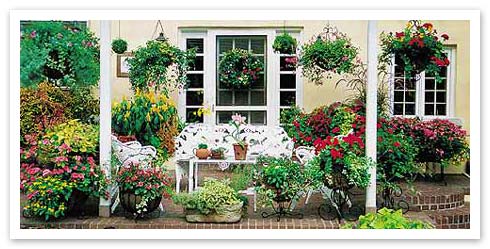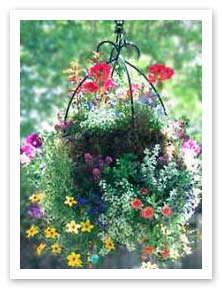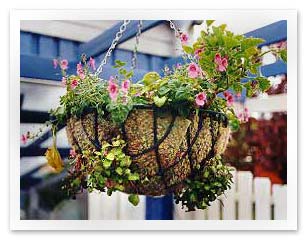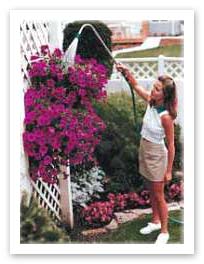Hanging baskets, planters or window boxes full of flowers or foliage plants give a colour boost to your house, patio and garden. They can be used effectively even in a very small space.
If you choose plants carefully, you can change the plantings to suit every season and add colour and texture to your environment.

POTTING MIXES:
A lightweight potting mix is needed for container gardening. Soil-less planting mixes provide excellent drainage, aeration and water-holding capacity that ordinary garden soil can not supply.
 Be sure that your basket or window box has drainage holes. Drainage is essential so that the planting mix will not become water-logged.
Be sure that your basket or window box has drainage holes. Drainage is essential so that the planting mix will not become water-logged.
Do not bother placing pebbles or other material at the bottom of the container as they will not provide better drainage. Its an old idea from the times when people only used garden soil which is so fine it could block up the drainage holes in flower pots – the pebbles helped keep those holes clear.
Plastic or wire baskets are available for hanging or mounting on the wall. Both have advantages and disadvantages. Plastic is inexpensive, easy to plant and is slower to dry out. Wire baskets allow more choices in size and planting arrangements.
Window boxes are usually plastic, wood or long wire baskets with liners. Liners are used to hold the soil and plants in position and can be made of dried sphagnum moss, wool or coconut fibre also known as coir. They also help maintain moisture, which is why sphagnum moss is so good.
Window boxes and baskets may need a strong support system. Remember that the containers will be much heavier when watered.
Choose small, healthy young plants for planting. They will adapt to new surroundings much faster than older plants.
Plant much closer in a box or basket than you would in a flowerbed. Include plants with a variety of colours, shapes and textures.
Trailing plants should be planted at the edges and bushy or upright plants will go at the centre or back. Be sure that the taller plants will not block your windows or interfere with hanging the basket.
Site selection is as important for baskets and boxes as it is for any other plant. Remember that most of the time the hanging basket will be viewed from below.
Hang the basket so that it will be close to eye level so that it can be admired and watered easily.
Window boxes should extend the entire width of the window for best appearance.
PLANTING A MOSS LINED BASKET:

- Secure the basket by placing it in the top of a round container of slightly less diameter - this will stop it wobbling on a flat surface and make it easier to plant.
- Squeeze as much water out of the moss as you can.
- Pack the moss in between the wires tightly from the inside of the basket.
- Add potting or basket mixture, going up as far as the top of this first layer of moss.
- Water plants well before planting.
- Crumble peat pots away from plants grown in them so that it will not suck water away from the roots.
- Pack your selection of plants in tightly - the more the merrier and the more colourful the final outcome
- Pinch off flowers on new transplants to promote sturdy growth
PLANTS FOR CONTAINERS:
Many types of plants will grow in containers including annuals, vines, tropical plants, herbs and even some vegetables.
For hanging salads, grow leaf lettuce, parsley and miniature tomatoes. Herbs go well in containers and require little care.
Thyme, oregano and rosemary are good for containers because they like the soil to dry out between waterings.
Many plants normally grown as houseplants will be great for foliage in outdoor containers also.

MAINTENANCE:
Containers can dry out very quickly. Daily or even twice-daily watering may be necessary.
Feel the soil to determine whether or not it is damp. If the potting mix feels dry 2-3cms below the surface, it is time to water. Apply water until it runs out the drainage holes. If the pot dries out too much you should immerse it in water to resoak the soil mix.
 Containers will need frequent checking as the plants grow and temperatures become hotter.
Containers will need frequent checking as the plants grow and temperatures become hotter.
Try a soil wetting agent – this breaks down the surface tension of the soil allowing the moisture to be retained much longer – it can be a very useful plantsaver if you go away for a short break.
You can also mulch your pots and baskets, it will help minimise water evaporation.
Watering wands are good tools for difficult-to-reach baskets and window boxes. They extend your reach and produce a gentle shower. But beware, frequent watering flushes nutrients from the soil quickly, so frequent fertilizing is also necessary.
Liquid fertilizers or timed-release fertilizers are the easiest methods of application.
Time-release fertilizer pellets like Osmocote can be mixed into the soil at planting or worked into the top inch later.
The soil in the container should be moist when fertilizer is applied, even liquid fertilizer.
Feed baskets and boxes every two weeks from spring through summer with a complete liquid fertilizer diluted to half-strength.
Remove flowers as they fade to keep flowering baskets blooming well. Many plants are rejuvenated by a trim in late summer.
There are so many different types of baskets – wall mounted, hanging, window boxes, planters – plenty of opportunity to increase the flower and foliage of anyone’s garden courtyard or balcony.
©GardensOnline